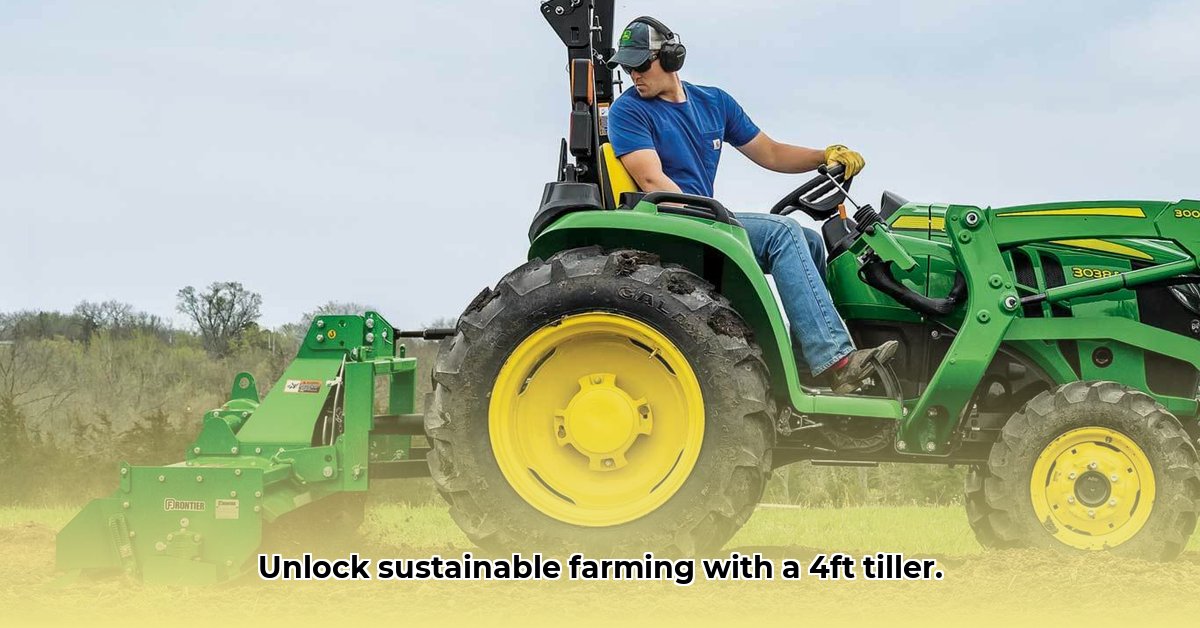
Choosing Your 4ft Tractor Tiller: A Guide to Sustainable Soil Management
A 4ft rotary tiller is an invaluable tool for small-scale sustainable agriculture, offering efficient soil preparation for various crops. This guide provides practical advice on selecting and utilizing a 4ft tiller, emphasizing techniques that promote soil health and minimize environmental impact. For more detailed specs, check out this helpful resource: Tiller information.
Power Requirements: Matching the Tiller to Your Tractor and Soil
Selecting a tiller with the right horsepower is critical. An underpowered tiller struggles in heavy clay soils, leading to inefficient operation and potential equipment damage. Conversely, an overpowered tiller may compact the soil. Consult your tractor's manual to determine its PTO (Power Take-Off) horsepower. Match this to the tiller's recommended horsepower range; heavier soils necessitate more powerful tillers. Do you have the right horsepower for your soil type? This crucial step ensures efficient and effective tilling.
Tilling Depth and Width: Optimizing Soil Health
The tilling depth profoundly impacts soil health. Shallow tillage (minimizing soil disruption) preserves beneficial soil organisms and reduces erosion. Deeper tillage might be necessary for specific crops or soil types, but it should be employed cautiously and strategically. The 4ft width offers consistent coverage; however, consider your field size when making your selection. Adjusting depth and width is crucial for achieving optimal soil conditions and promoting crop growth.
Key Features to Consider for Sustainable Tilling
Several features significantly influence a 4ft tiller's performance and longevity. Adjustable tilling depth allows customization for varied soil conditions and crop types. Different tine types (the rotating blades) are suited to different soil textures – heavy-duty tines for clay, lighter ones for sandy soil. A robust PTO (power take-off) shaft is essential for reliable power transmission and prevents damage. Safety features, such as shields and readily accessible shut-off switches, are paramount for operator protection. These features contribute to a safer and more productive tilling experience.
Maintenance: Extending the Lifespan of Your Tiller
Regular maintenance is crucial for maximizing the lifespan and efficiency of your tiller. After each use, thoroughly clean the tiller to remove soil and debris. Regular lubrication of moving parts reduces wear and tear. Inspect tines for damage and replace them promptly as needed. Proper storage, in a dry, protected area during the off-season, further extends the tiller's life. Proactive maintenance practices significantly reduce long-term costs and maximize your investment.
Budgeting for Your 4ft Rotary Tiller
The cost of a 4ft rotary tiller varies considerably depending on brand, features, and build quality. Higher-quality tillers generally command a premium price, but often offer superior durability and longer lifespans. Include maintenance expenses in your budget; even the best tillers require periodic servicing and part replacement. A balanced approach to initial investment and long-term maintenance costs is key to long-term cost-effectiveness.
Sustainable Tilling Practices: Promoting Soil Health
Sustainable agricultural practices prioritize soil health. The following techniques optimize soil conditions and minimize environmental impact:
Minimizing Soil Disturbance: Less is More
Excessive tilling disrupts soil structure, leading to erosion, compaction, and the loss of beneficial soil organisms. Employ minimal tillage techniques whenever possible. Consider no-till or conservation tillage methods to reduce soil disturbance and enhance soil health.
Cover Cropping: Enhancing Soil Fertility
Cover crops improve soil quality by providing organic matter, enhancing nutrient cycling, and suppressing weeds. A 4ft tiller can effectively incorporate cover crops back into the soil, enriching the soil profile and improving its overall health and fertility.
No-Till and Conservation Tillage: Preserving Soil Structure
No-till and conservation tillage techniques largely eliminate or minimize the use of tillage. When integrated with your 4ft tiller (perhaps using it to prepare only specific planting areas), these methods preserve soil structure, increase biodiversity, and improve water infiltration.
Soil Health Monitoring: A Continuous Feedback Loop
Regular soil testing provides invaluable feedback on the effects of your tilling practices. Monitoring soil texture, nutrient levels, and water retention allows you to adjust techniques for optimal soil health and crop production. Soil testing is a key component of a successful and sustainable farming strategy.
Troubleshooting Common Issues with Your 4ft Rotary Tiller
Problems may arise; here are troubleshooting tips:
Difficult Operation: Insufficient power or excessively hard soil may hinder operation. Ensure your tractor has adequate horsepower and consider adjusting tilling depth.
Irregular Tilling: Check for bent or damaged tines, and ensure they are properly adjusted and sharp.
Clogged Tines: Remove any obstructions from the tines.
Excessive Vibration: Check for misalignment or worn parts.
Always consult your tiller's manual for detailed troubleshooting guidance.
Conclusion: Tilling Responsibly for a Sustainable Future
Selecting and using a 4ft rotary tiller effectively involves understanding power requirements, tilling depth and width, key features, and the critical role of maintenance. By combining sound equipment choices with sustainable tillage practices, you can promote soil health, minimize environmental impact, and build a prosperous, ecologically responsible farm.